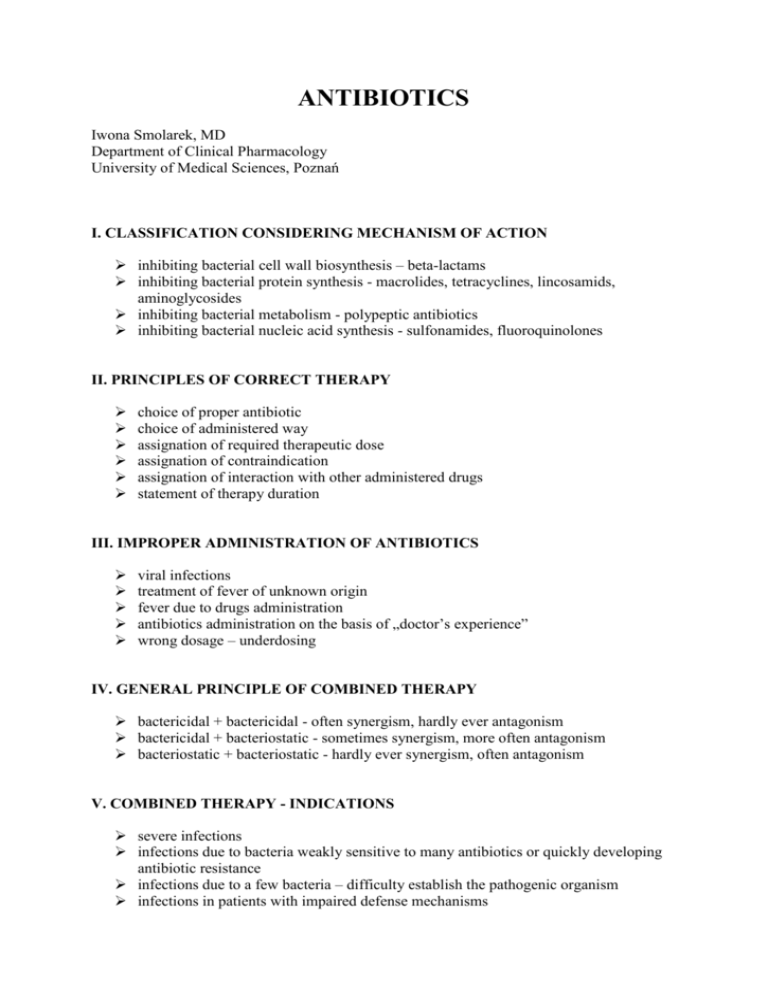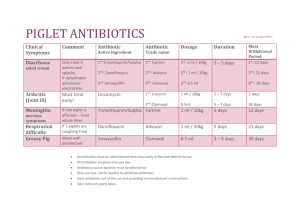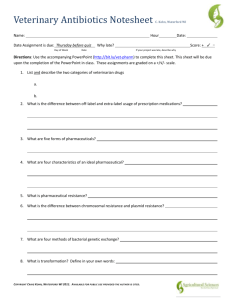ANTIBIOTICS
advertisement

ANTIBIOTICS Iwona Smolarek, MD Department of Clinical Pharmacology University of Medical Sciences, Poznań I. CLASSIFICATION CONSIDERING MECHANISM OF ACTION inhibiting bacterial cell wall biosynthesis – beta-lactams inhibiting bacterial protein synthesis - macrolides, tetracyclines, lincosamids, aminoglycosides inhibiting bacterial metabolism - polypeptic antibiotics inhibiting bacterial nucleic acid synthesis - sulfonamides, fluoroquinolones II. PRINCIPLES OF CORRECT THERAPY choice of proper antibiotic choice of administered way assignation of required therapeutic dose assignation of contraindication assignation of interaction with other administered drugs statement of therapy duration III. IMPROPER ADMINISTRATION OF ANTIBIOTICS viral infections treatment of fever of unknown origin fever due to drugs administration antibiotics administration on the basis of „doctor’s experience” wrong dosage – underdosing IV. GENERAL PRINCIPLE OF COMBINED THERAPY bactericidal + bactericidal - often synergism, hardly ever antagonism bactericidal + bacteriostatic - sometimes synergism, more often antagonism bacteriostatic + bacteriostatic - hardly ever synergism, often antagonism V. COMBINED THERAPY - INDICATIONS severe infections infections due to bacteria weakly sensitive to many antibiotics or quickly developing antibiotic resistance infections due to a few bacteria – difficulty establish the pathogenic organism infections in patients with impaired defense mechanisms VI. ADVERSE EFFECTS OF ANTIBIOTICS disturbances of biological balance gastrointestinal disturbances allergic reactions organ toxicity VII. ORGAN TOXICITY OF ANTIBIOTICS hepatotoxicity – macrolides, tetracyclines neurotoxicity – penicillins myelotoxicity – chloramphenicol nephrotoxicity – aminoglycosides, vancomycin ototoxicity – aminoglycosides, vancomycin VIII. ANTIBIOTICS IN PREGNANT WOMEN indicated: β – lactams macrolides lincosamids ruthlessly contraindicated: tetracyclines chloramphenicol polypeptic antibiotics relatively contraindicated: aminoglycosides IX. PROPHYLAXIS OF ENDOCARDITIS Prophylaxis should only be considering for patients at highest risk of IE: 1) prosthetic valve or a prosthetic material used for cardiac valve repair 2) previous IE 3) congenital heart disease cyanotic, without surgical repair, or with residual defects, palliative shunts or conduits with complete repair with prosthetic material whether placed by surgery or by percutaneous technique, up to 6 months after the procedure when a residual defects persist at the site of implantation of a prosthetic material or device by cardiac surgery or percutaneous technique Antibiotic should only be considered for dental procedures requiring manipulation of the gingival or periapical region of the teeth or perforation of the oral mucosa. No allergy to pencillin or ampicillin amoxicillin or ampicillin 2 g p.o. or i.v. in adults and 50 mg/kg p.o. or i.v. single dose 30-60 minutes before procedure alternatively cephalexin, cefazolin, or ceftriaxon i.v. (Cephalosporins should not be used in patients with anaphylaxis, angio-oedema, or urticaria after intake of penicillin and ampicillin) Allergy to pencillin or ampicillin clindamycin 600 mg p.o. or i.v. in adults and 20 mg/kg p.o. or i.v. single dose 30-60 minutes before procedure X. THREE MAIN PROBLEMS OF MODERN ANTIBIOTIC THERAPY lack of progress in new antibiotics researches i.e. drugs with different structure or mechanism of action disregard of indications of antibiotics company by physicians resistance on antibiotics (inside and outside of hospitals) XI. MECHANISM OF RESISTANCE AGAINST ANTIBIOTICS – change/loss of therapeutic value appereance of bacterial chromosome mutation extrachromosomal transmission of genes of resistance by means of plasmids, transposons („leaping genes”), genetic casettes The results of chromosome mutations and extrachromosomal transmission of genes enzymatic breakdown of drug diminished uptake of antibiotic active removal of antibiotics by bacterial strain diminished binding ability of antibiotic with bacterial structures XII. LIMITATION IN RESEARCH OF NEW ANTIBIOTICS (non-profitability!) the atributes of new antibiotics must be studied (10- years clinical researches for exact therapeutic indications, high costs) resistance may occur after registration delay and limitation of extent of researches by small biotechnological companies (e.g. for infection of cutis and subcutaneous tissue of patients in good general condition) XIII. METICILLIN RESISTANCE S. AUREUS (MRSA) – PBP2 protein All beta- lactams are ineffective! Even „high level” beta-lactams e.g. CARBAPENEMS are ineffective! Effective are new antibiotics: oxalizolidinones - linezolid, lipopeptides – daptomycin and vancomycin, teicoplanin XIV. LINEZOLID member of the oxazolidinones, a new class of synthetic antimicrobials registered in 2000 active against gram-positive organisms including Staphylococci (MRSA), Streptococci, Enterococci (VRE), gram-positive anaerobic cocci and gram-positive rods such as Corynebacteria and Listeria monocytogenes in vitro active against Mycobacterium tuberculosis used to treatment of cutis and connective tissue infections, pneumonia (inside of hospitals) and sepsis The unique mechanism blocking protein synthesis in early stage! bind to the 50S subunit of bacterial ribosomes block forming of initation complex (30S, 50 S and t RNA, mRNA) – destabilisation of tRNA connecting position lack of cross resistance of inhibiting protein synthesis antibiotics (chloramphenicol, linkosamides, macrolides, tetracyclines, streptogramins) Adverse effects allergy diarrhea vomiting headache thrombocytopenia Interaction MAO inhibitors Linezolid is recommended as guided and empirical therapy of pneumonias and pes diabetic if MRSA infection is confirmed or highly probable in alternative to vancomycin in USA.




